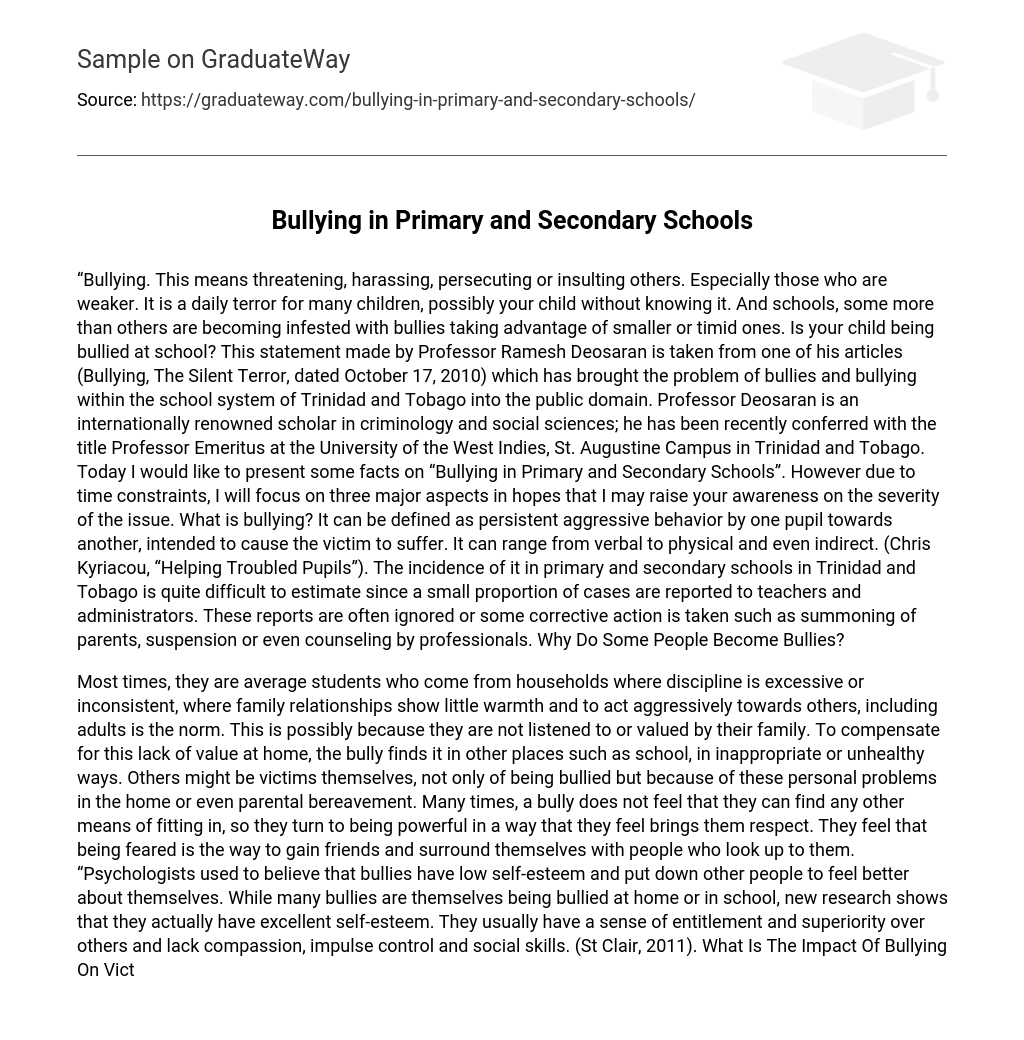Introduction
Bullying, which involves threatening, harassing, persecuting, or insulting others, especially those who are more vulnerable, is a continuous source of fear for numerous children. It may even be affecting your own child unknowingly. Regrettably, schools vary in their prevalence of bullies who target individuals smaller or less assertive than them.
Professor Ramesh Deosaran’s article, “Bullying, The Silent Terror,” published on October 17, 2010, has drawn attention to the issue of bullying in Trinidad and Tobago’s education system. This has ignited public debate and heightened worries regarding students facing bullying in schools.
Professor Deosaran, a renowned expert in criminology and social sciences, was recently honored as Professor Emeritus at the University of the West Indies, St. Augustine Campus in Trinidad and Tobago. In this presentation, I will discuss “Bullying in Primary and Secondary Schools,” emphasizing three key aspects to underscore its significance within the given time limitations.
What is bullying?
According to Chris Kyriacou, “Helping Troubled Pupils,” bullying is the persistent aggressive behavior of one student towards another, with the intention of causing harm. This can be through verbal, physical, or indirect actions. In primary and secondary schools in Trinidad and Tobago, determining the prevalence of bullying is difficult as few cases are reported to teachers and administrators. Additionally, these reports are often ignored or dealt with by involving parents, suspending students, or seeking professional counseling.
Why Do Some People Become Bullies?
These individuals are usually students who come from households with excessive or inconsistent discipline, limited warmth in family relationships, and a norm of aggressiveness towards others, including adults. This behavior may be a result of feeling disregarded or undervalued by their families. To make up for this lack of appreciation at home, the bully looks for validation elsewhere and often resorts to inappropriate or unhealthy methods within the school setting. They might have also been victims of bullying themselves or are dealing with personal issues at home like parental loss.
St. Clair (2011) states that bullies frequently employ their power to earn respect and conform, as they believe that instilling fear will attract admirers. In the past, psychologists believed that bullies had low self-esteem and belittled others to boost their own self-worth. Nevertheless, recent research suggests that bullies generally possess high self-esteem and exhibit a sense of entitlement and superiority towards others. They lack empathy, impulse control, and social skills, which could stem from being subjected to bullying either at home or school.
What Is The Impact Of Bullying On Victimized Students?
According to the Global School Based Student Health Survey (GSHS) conducted in 2007, selected schools in Trinidad and Tobago have discovered the detrimental consequences of bullying on its victims. Those who are subjected to bullying experience elevated stress levels and encounter difficulties with concentration. Moreover, they face an increased likelihood of participating in substance abuse, exhibiting aggressive behavior, and contemplating suicide. Additionally, these individuals may develop mental health disorders, become truants or refuse to attend school altogether, and underperform academically compared to their true potential if the bullying persists over time. Alongside these challenges, they often grapple with diminished self-esteem and encounter social isolation due to being labeled as “different” by the bully while lacking support from their peers.
According to Roland (2002), bullying directly leads to a significant increase in depression among its victims. Certain individuals who are targeted by bullies may come to view bullying as a typical aspect of childhood, thereby jeopardizing their emotional welfare and hindering their educational growth. Consequently, this can result in a decline in their capacity to acquire effective coping mechanisms, which could potentially impact their ability to handle challenges in adulthood and establish lasting connections.
What Is Being Done By the Authorities In Trinidad and Tobago?
Currently, the Ministry of Education has implemented Human and Family Life Education (HFLE) in secondary schools’ curriculum, which is taught in most schools. The Minister of Education, Tim Gopeesingh, stated on April 14, 2012, that the Government of Trinidad and Tobago is focusing on the prevention, early detection, and treatment of this issue. Additionally, preventative measures like “The Leader in Me” program have been introduced from preschool to secondary schools.
Student Guidance Support Units in schools are being expanded and a hotline is being set up for children who are bullied. Additionally, the Chief Education Officer has sent a curriculum to all schools, requesting principals to allocate one class per week (Form Teacher Period) for students to share their difficulties.
Challenges and Evaluation of Sources
During my research, I encountered several challenges. One of the main obstacles was managing a large volume of information. It was time-consuming to summarize and select the most relevant points. However, I relied on reputable sources such as ttparliament.org, bullyonline.org, stopbullying.gov, and youthoria.org. These sites were consistently maintained by their respective organizations and offered up-to-date articles. Additionally, “Helping Troubled Pupils” by Chris Kyriacou proved valuable as it dedicated a whole chapter to bullying. From this book authored by a psychologist, I extracted multiple valid points, considering it a trustworthy source for teachers and parents seeking assistance.
Conclusion
Trinidad and Tobago is experiencing an increasing worry regarding the recent surge in bullying among youths. The Government is presently taking steps to tackle this significant problem by adopting preventive measures and providing education to students and the public. Nevertheless, it is recognized that eradicating bullying entirely from primary and secondary schools may be impossible.





